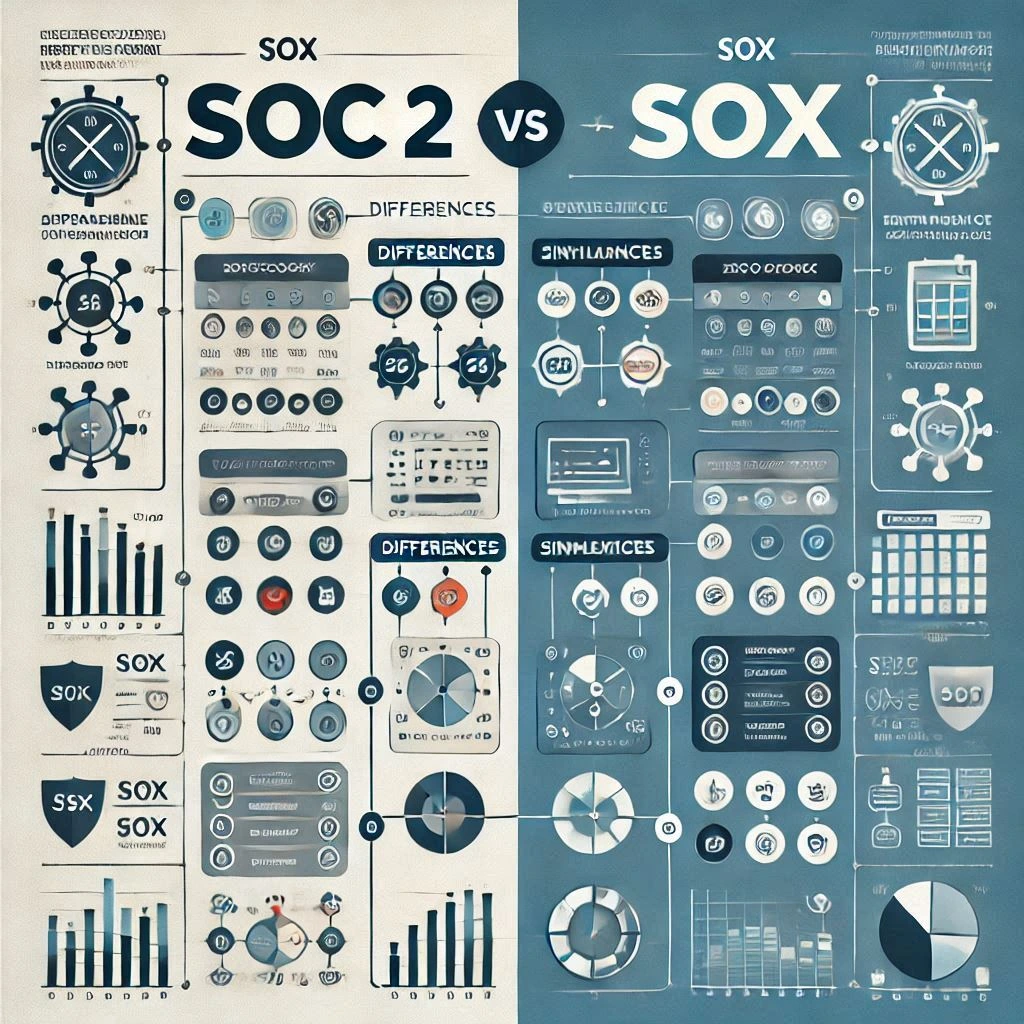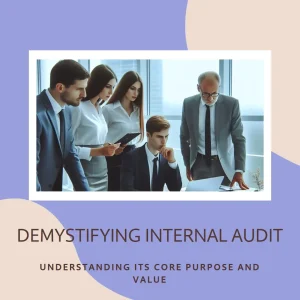Introduction
Understanding the various frameworks that govern financial reporting and data security is crucial for professionals tasked with ensuring organizational integrity. Two prominent frameworks that often come into discussion are SOC 2 and SOX.
Defining SOC 2 and SOX Frameworks
- SOC 2 (System and Organization Controls 2) is a framework designed specifically for service organizations that manage customer data. It focuses on five trust service criteria: security, availability, processing integrity, confidentiality, and privacy. SOC 2 compliance is essential for organizations that handle sensitive information, as it assesses the effectiveness of their controls in protecting that data [5][14].
- SOX (Sarbanes-Oxley Act), on the other hand, is a U.S. federal law enacted in 2002 to protect investors by improving the accuracy and reliability of corporate disclosures. It mandates strict reforms to enhance financial reporting and accountability, primarily targeting publicly traded companies. SOX compliance ensures that organizations maintain robust internal controls over financial reporting, thereby safeguarding against fraud and inaccuracies [1][8].
Relevance in the Audit and Compliance Landscape
Both SOC 2 and SOX play pivotal roles in the audit and compliance landscape, albeit with different focuses. SOC 2 is particularly relevant for service organizations that need to demonstrate their commitment to data security and operational integrity to clients and stakeholders. In contrast, SOX is critical for publicly traded companies, ensuring that they adhere to stringent financial reporting standards and maintain transparency in their operations [2][9].
Purpose of the Blog Post
This blog post aims to provide a comprehensive comparative analysis of the SOC 2 and SOX frameworks. By examining their definitions, relevance, and implications for audit and compliance professionals, we will equip readers with the knowledge necessary to navigate these frameworks effectively. Understanding the distinctions and intersections between SOC 2 and SOX will empower organizations to implement the appropriate controls and practices that align with their operational and regulatory requirements.
Overview of SOC 2 Framework
The SOC 2 framework, formally known as “System and Organization Controls 2,” was developed by the American Institute of Certified Public Accountants (AICPA) to provide a standardized approach for service organizations to demonstrate their commitment to data security and privacy. This framework is particularly relevant for technology and cloud service providers, as it addresses the unique challenges associated with managing sensitive customer data in a digital environment.
Origin and Purpose of SOC 2
SOC 2 was introduced as part of the broader SOC reporting framework, which includes SOC 1 and SOC 3 reports. The primary purpose of SOC 2 is to ensure that service organizations implement effective controls to protect customer data and maintain the trust of their clients. Unlike SOC 1, which focuses on financial reporting controls, SOC 2 emphasizes operational controls related to data security, making it essential for organizations that handle sensitive information, especially in the cloud computing sector [2][7].
Trust Services Criteria
The SOC 2 framework is built around five Trust Services Criteria (TSC), which serve as the foundation for evaluating the effectiveness of an organization’s controls. These criteria are:
- Security: This criterion focuses on protecting the system against unauthorized access, both physical and logical. It includes measures such as firewalls, intrusion detection systems, and access controls to safeguard sensitive data.
- Availability: This aspect ensures that the system is operational and accessible as agreed upon. It involves assessing the organization’s ability to maintain uptime and provide services without interruption.
- Processing Integrity: This criterion evaluates whether the system processes data accurately and without error. It ensures that data is processed in a complete, valid, and timely manner.
- Confidentiality: This criterion addresses the protection of sensitive information from unauthorized disclosure. Organizations must implement controls to ensure that confidential data is only accessible to authorized individuals.
- Privacy: This aspect focuses on the organization’s ability to manage personal information in accordance with privacy regulations and policies, ensuring that data is collected, used, and disclosed appropriately [6][10].
Importance of SOC 2 for Service Organizations
SOC 2 compliance is crucial for service organizations, particularly those operating in the cloud computing space. As businesses increasingly rely on third-party service providers to manage their data, the need for assurance regarding data security and privacy has become paramount. A SOC 2 report provides stakeholders with confidence that the organization has implemented robust controls to protect sensitive information.
Moreover, obtaining a SOC 2 attestation can enhance a service organization’s reputation, making it more attractive to potential clients who prioritize data security. It also helps organizations identify and mitigate risks associated with data breaches and non-compliance with regulatory requirements, ultimately fostering trust and long-term relationships with customers [1][4][12].
Overview of SOX Framework
The Sarbanes-Oxley Act (SOX), enacted in 2002, was a legislative response to major corporate scandals, including those involving Enron and WorldCom. Its primary purpose is to enhance corporate governance and accountability, ensuring that companies adhere to strict financial reporting standards. The act aims to protect investors by improving the accuracy and reliability of corporate disclosures made pursuant to the securities laws.
Key Provisions of SOX
- Section 404: This section mandates that publicly traded companies establish and maintain an adequate internal control structure and procedures for financial reporting. Companies are required to assess the effectiveness of these controls annually and have their assessments audited by an external auditor. This provision is crucial as it holds management accountable for the accuracy of financial statements and the integrity of the internal control systems.
- Section 302: This section requires the CEO and CFO to personally certify the accuracy of financial statements and disclosures. They must ensure that the financial reports are free from material misstatements and that they have established and maintained internal controls over financial reporting. This provision emphasizes the responsibility of top executives in safeguarding the integrity of financial reporting.
Implications of SOX for Publicly Traded Companies
The implications of SOX for publicly traded companies are significant:
- Increased Accountability: SOX imposes stringent penalties for fraudulent financial activity, which enhances accountability among executives and board members. This has led to a cultural shift within organizations, prioritizing ethical financial practices.
- Enhanced Internal Controls: Companies must invest in robust internal control systems to comply with SOX requirements. This often involves hiring additional staff, implementing new technologies, and conducting regular audits, which can increase operational costs.
- Investor Confidence: By enforcing stricter regulations on financial reporting, SOX aims to restore investor confidence in the capital markets. The act has contributed to a more transparent financial environment, which is essential for attracting and retaining investors.
Key Differences Between SOC 2 and SOX
Both frameworks serve important roles in ensuring organizational integrity and security, but they differ significantly in their goals, regulatory requirements, audit processes, and consequences of non-compliance. Below is a comparative analysis of these two frameworks.
Goal and Scope
- SOC 2: The primary focus of SOC 2 is on the internal controls of service organizations, particularly regarding data security, availability, processing integrity, confidentiality, and privacy. It is designed to ensure that service providers manage customer data securely and in compliance with established criteria, which is essential for building trust with clients and stakeholders [5][13].
- SOX: In contrast, the Sarbanes-Oxley Act (SOX) is centered on corporate governance and financial reporting. Its main objective is to protect investors by enhancing the accuracy and reliability of corporate disclosures. SOX mandates strict reforms to improve financial transparency and accountability within publicly traded companies [4][14].
Regulatory Requirements
- SOC 2: Compliance with SOC 2 is voluntary and is often driven by client expectations and industry standards. Organizations may choose to undergo SOC 2 audits to demonstrate their commitment to data security and to meet the demands of clients who require assurance regarding their data handling practices [14][15].
- SOX: Conversely, SOX compliance is mandatory for all publicly traded companies in the United States. The act was enacted in response to financial scandals and is enforced by the U.S. Securities and Exchange Commission (SEC). Non-compliance can lead to severe penalties, including fines and imprisonment for executives [4][14].
Audit Process
- SOC 2 Audit: The SOC 2 audit process involves evaluating the effectiveness of a service organization’s controls over a specified period. There are two types of SOC 2 reports: Type 1, which assesses the design of controls at a specific point in time, and Type 2, which evaluates the operational effectiveness of those controls over a defined period [11][12].
- SOX Compliance Audit: The SOX audit process is more comprehensive and focuses on the internal controls over financial reporting (ICFR). It requires organizations to document their internal controls, conduct regular assessments, and report on their effectiveness. The audit results in a compliance report that must be filed with the SEC, detailing the company’s adherence to SOX requirements [1][4].
Penalties and Consequences
- SOC 2 Non-Compliance: While SOC 2 is voluntary, failing to comply can result in loss of business opportunities, as clients may choose not to engage with organizations that do not demonstrate adequate data security practices. Additionally, it can damage an organization’s reputation and trustworthiness in the market [14][15].
- SOX Non-Compliance: The repercussions of non-compliance with SOX are significantly more severe. Companies that fail to comply can face hefty fines, legal penalties, and even criminal charges against executives. The act also allows for civil penalties, which can include the loss of business licenses and reputational damage that can affect stock prices and investor confidence [4][14].
Key Similarities Between SOC 2 and SOX
Understanding the commonalities between the SOC 2 and SOX frameworks is essential for professionals aiming to enhance organizational integrity and accountability. Here are the key similarities that highlight their relevance:
- Establishing Trust and Accountability: Both SOC 2 (Service Organization Control 2) and SOX (Sarbanes-Oxley Act) frameworks are designed to foster trust and accountability within organizations. They provide a structured approach to ensure that organizations adhere to established standards, thereby enhancing stakeholder confidence in their operations and financial reporting [11].
- Importance of Internal Controls and Risk Management: A fundamental aspect of both frameworks is the emphasis on robust internal controls and effective risk management practices. SOC 2 focuses on controls related to security, availability, processing integrity, confidentiality, and privacy, while SOX mandates internal controls over financial reporting to prevent inaccuracies and fraud [1][14]. This shared focus underscores the necessity for organizations to implement comprehensive internal controls to mitigate risks effectively.
- Role of Independent Audits: Independent audits play a crucial role in both SOC 2 and SOX compliance. These audits are conducted by certified public accountants to validate that organizations meet the required standards. For SOC 2, audits assess the effectiveness of controls related to the Trust Services Criteria, while SOX audits ensure compliance with financial reporting requirements [6][13]. This independent verification is vital for maintaining transparency and accountability in organizational processes.
- Protection of Stakeholder Interests: Both frameworks prioritize the protection of stakeholder interests, albeit from different angles. SOC 2 emphasizes safeguarding customer data and ensuring service reliability, which is critical for maintaining client trust. Conversely, SOX focuses on protecting investors and the public by ensuring the accuracy of financial statements and preventing corporate fraud [12][14]. This alignment in purpose highlights the overarching goal of both frameworks to uphold the integrity of organizational operations.
When to Use SOC 2 vs. SOX
Understanding when to utilize SOC 2 versus SOX is crucial for organizations aiming to meet their regulatory obligations and enhance their operational integrity. Below is a comparative analysis that outlines the scenarios in which each framework is most beneficial, as well as the potential for organizations to implement both.
Scenarios Where SOC 2 is Beneficial
- SaaS Providers: Organizations that offer Software as a Service (SaaS) solutions often handle sensitive customer data. SOC 2 compliance is particularly advantageous for these providers as it focuses on the security, availability, processing integrity, confidentiality, and privacy of customer data. This framework helps build trust with clients by demonstrating robust data protection measures [6][13].
- Data Centers: For data centers that manage and store large volumes of data, SOC 2 is essential. It provides assurance to clients regarding the effectiveness of the data center’s controls related to security and privacy, which is critical for maintaining client relationships and meeting contractual obligations [6][13].
- Service Organizations: Any service organization that processes or stores customer data can benefit from SOC 2 compliance. This framework is designed to assure clients that their data is handled securely and in compliance with industry standards, making it a valuable asset for organizations looking to enhance their reputation and client trust [11][12].
Situations Where SOX Compliance is Required
- Publicly Traded Companies: The Sarbanes-Oxley Act (SOX) is mandatory for publicly traded companies in the United States. It focuses on financial transparency and the integrity of financial reporting, ensuring that companies maintain accurate financial statements to protect investors [3][9]. Organizations in this category must comply with SOX to avoid legal repercussions and maintain investor confidence.
- Companies Seeking Investment: Organizations that are planning to go public or seeking significant investment may also need to adhere to SOX compliance. Investors often require assurance that the company has robust internal controls in place to safeguard their investments and ensure accurate financial reporting [3][9].
- Financial Institutions: Financial institutions are also subject to SOX compliance due to the critical nature of their operations and the need for stringent financial oversight. Compliance with SOX helps these organizations mitigate risks associated with financial misreporting and fraud [3][9].
Potential for Implementing Both Frameworks
Organizations may find it beneficial to implement both SOC 2 and SOX frameworks, especially if they operate in sectors that require adherence to both data security and financial reporting standards.
- Integrated Approach: By adopting both frameworks, organizations can create a comprehensive compliance strategy that addresses both operational and financial controls. This integrated approach not only enhances overall governance but also builds greater trust with stakeholders by demonstrating a commitment to both data security and financial integrity [11][12].
- Enhanced Risk Management: Implementing both SOC 2 and SOX can lead to improved risk management practices. Organizations can leverage the strengths of each framework to create a more resilient internal control environment, ensuring that they are well-prepared to handle both data security and financial reporting challenges [12][13].
Conclusion
Understanding both frameworks is essential for audit and compliance professionals, as they serve different yet complementary purposes in ensuring organizational integrity and security. By evaluating their specific organizational needs, professionals can determine which framework(s) to prioritize, thereby enhancing their compliance posture and fostering trust with stakeholders.
Find out more about Shaun Stoltz https://www.shaunstoltz.com/about/
This post was written by an AI and reviewed/edited by a human.



